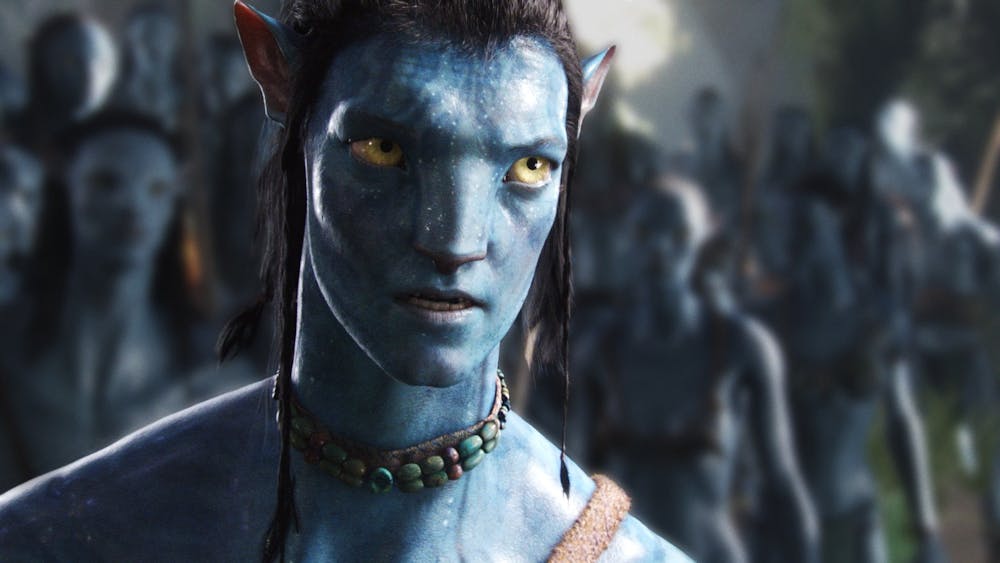Hair sex aside: In defense of “Avatar,” 13 years later
Listen, I get it: blue cat-people, Unobtanium, Sam Worthington and hair sex, if you watch the extended edition. James Cameron’s “Avatar,” released in 2009, is inherently a little bit bad. But watching the re-release in IMAX 3D this week, I can’t help but find myself completely bought in anyway — visually stunning, emotionally compelling and technologically impressive, I hate to say that “Avatar” is kind of good.
At first, I worried it wouldn’t hold up to my expectations upon rewatch. The beginning, both too fast and too slow, finds itself bogged down by exaggerated exposition and Worthington’s bland, emotionless narration. However, once we enter the forests of Pandora, the film takes off like a banshee, and it doesn’t slow down.
Though critics often detract from its cultural importance, “Avatar” brought in over $30 million at the box office thirteen years after its release, proving its staying power last weekend when it returned to theaters in promotion of its upcoming sequel, “Avatar: The Way of the Water.”
This being said, the film severely suffers in some key areas. The allegorical narrative is that of the white savior, and the Na’vi tribe is represented as an infantilized amalgamation of Indegenous tribes and cultures; even for 2009, they’re flat and offensive.
Cameron, in making Jake Sully the savior of the Na’vi people, intended him to represent the way the white man can make amends and serve as an ally to Indigenous communities, but taken in conjunction with his messianic characterization and messy body politics of being an “Avatar” (it’s own unexamined and insidious form of colonization), this doesn’t work.
Taking its immature politics in conjunction with the thin and predictable plot and often wooden performances that come with the genre, this movie has more than earned its fair share of criticism.
Still, the genre occasionally detracts, a lot of the film’s strength lie in these flaws, which I lovingly refer to as sci-fi bullshit. The precious mineral being called “Unobtanium,” the Na’vi’s neural hair tendrils — though the movie certainly takes itself seriously, it’s not afraid to be unabashedly genre.
The conceits of the film are inherently absurd, but Cameron doesn’t make fun of them. Imagine how a modern blockbuster would handle these elements of the world — “Um, our mineral is called Unobtanium? Un-obtain-ium. Don’t you think that’s a little on the nose?”
This self-seriousness, in combination with the marvelous motion capture and CGI, makes “Avatar” a refreshing trip to the movies for modern audiences who are deservedly tired of the superhero schlock. Take in combination the nostalgia of the 3D glasses and the predictability, and you’ve got a great mindless trip to the movies.
Normally, an overly predictable plot is a downside, but with “Avatar” it works, building the audience to an explosive climax complete with a helicopter dogfight, a Na’vi versus Stephen Lang mech showdown, and more whip pans than you’d think a movie could fit in 2 hours and 41 minutes. The action is smooth, easy to follow and well-shot — it could’ve been ten minutes longer and I wouldn’t have minded.
Get content from The Daily Lobo delivered to your inbox
With Cameron’s delay of the sequel due to technological constraints of the time period, I hope to see a reappraisal not only of the work that goes into VFX but also of the workers’ rights considering the obscene and thankless hours asked by companies like Disney. If “Avatar” led us into a cul-de-sac of low-budget, high intensity CGI, here’s hoping “Avatar: Way of the Water” can lead us out, allowing us all to finally acknowledge that, like it or not, Cameron is king.
Spenser Willden is the culture editor at the Daily Lobo. He can be contacted at culture@dailylobo.com or on Twitter @spenserwillden
REVIEW: 13 years later, ‘Avatar’ is still a overhyped, problematic slog
It’s December 2009. “I Gotta Feeling” by the Black Eyed Peas is dominating the radio. The economy is in shambles. People still can’t get enough of the most recent “Twilight” movie that came out the month before. But you — all you are thinking about as you take your seat in a surprisingly crowded moviehouse with your 3D glasses is the film you are about to watch, a film that is about to become the highest-grossing movie of all time. Wait, sorry, I’m having trouble recalling the title … Oh! James Cameron’s “Avatar.”
Now, nearly 13 years later, “Avatar” is back in theaters to prep audiences for the long-gestating sequel, “Avatar: The Way of the Water.” You would have thought 13 years would give them enough time to think of a better title, but alas. Now feels like as good a time as ever to revisit the landmark blockbuster and ask the question: was the movie actually any good? At least good enough to justify multiple sequels being filmed back-to-back all these years later? The short answer is no; the long answer is also no.
Before I really get into the nuts and bolts of what makes “Avatar” such a shit show, I will say that it was quite nostalgic to watch the film in theaters again. I can’t remember the last time I watched something in 3D, let alone something in 3D with Sam Worthington as the lead.
However, this nostalgia quickly wore thin. As the nearly three-hour film went on, my eyes became sorer and sorer, equally suffering from the 3D glasses and straining to discern whatever Worthington was trying to do.
Yes, you read that runtime right: this film is a whopping 2 hours and 41 minutes, and it most certainly feels like it. This is one of the more disappointing aspects of the film. A majority of this runtime is spent with Worthington’s Jake Sully attempting to learn about and become one of the Na’vi people. This is great on paper, but in execution — when a majority of this time is spent going through stereotypical Indigenous people culture-isms — it makes the film feel longer than it needs to be.
Usually, by this point in a review, I will have provided a brief summary of the plot of the film. This is not the case with this one. It’s not because I’m assuming people have seen the movie at this point and already know what it’s about; it’s because you don’t need to see the movie to know what this film is about. It’s the same white savior narrative we’ve seen played out dozens of times in a number of different films.
Cameron was at least minutely aware of this and attempted to alleviate it through his detailed creation of the Na’vi and their home Pandora. Even with the absurd amount of detail that was poured into creating the customs, practices, language and look of the Na’vi, all we get on screen is this strange, vague Indigenous identity.
Of course, most people aren’t watching “Avatar” for the plot: they’re watching it for the special effects. “Avatar” set a precedent for motion capture technology when it first came out and, for the most part, it still holds up. I will refrain from any sort of nitpicks or squabbles I may have had with the CGI because it seems unfair to judge a film on special effects that are 13 years old. The CGI holds up quite well, and there were admittedly a few moments where I was impressed by what they were able to do with the technology.
One point I will allow myself in regards to the special effects is the actor’s performances. While Cameron was not setting himself up for success by casting Worthington, he’s the only one who’s performance translates quite well to his Avatar form, mainly because he’s just as wooden and stiff as he is as a human. All of the actors who are playing motion captured characters feel like they’re doing voiceover work; each CGI character only really has one discernible expression, and it never really changes.
My general feelings on “Avatar” can be summed up in one word: disappointment. It’s disappointing to see the amount of behind-the-scenes work that went into the world of “Avatar” that didn't make it into the film. It’s disappointing to see the highest-grossing film of all time could have been a steward for on-screen representation, but it wasn’t. Ultimately, it’s disappointing to see the precedent “Avatar” set in regards to over-reliance on CGI. At least now the bar is so low it will be hard for the sequels to be as disappointing.
John Scott is the editor-in-chief at the Daily Lobo. He can be contacted at editorinchief@dailylobo.com or on Twitter @JScott050901






